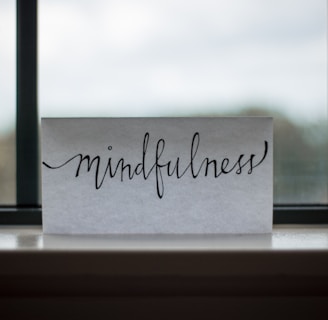The Squat Part 5: Mindfullness
Mind Squat
Coach Gabe
9/9/20248 min read


```html
Understanding the Importance of Mental Imagery in Squatting
Mental imagery, also known as visualization, is a psychological technique where individuals create vivid mental images of themselves performing specific actions or activities. In the context of physically demanding exercises like squats, mental imagery stands as a crucial element for improving performance and mastering the final outcome. The process involves envisioning the correct form, the feel of the muscles working, and the successful completion of each squat repetition.
The effectiveness of mental imagery stems from its ability to engage both psychological and neurological mechanisms. Psychologically, it can help athletes develop a strong mental blueprint of the movements they intend to perform. Neurologically, studies have shown that visualizing a physical task activates similar regions in the brain as actually performing the task. This mental rehearsal primes the neural pathways necessary for the effective execution of squats. For example, brain imaging research has indicated that athletes who regularly practice mental imagery demonstrate enhanced motor cortex activity, which translates into better muscle memory and coordination.
Scientific studies affirm the benefits of mental imagery, particularly in enhancing athletic performance. According to a study published in the Journal of Sports Science and Medicine, athletes who incorporated mental imagery into their training regime showed significant improvements in precision and control compared to those who did not. This research underscores the value of mental rehearsal in achieving peak performance, reducing anxiety, and increasing focus–critical components in mastering squats.
Beyond the scientific evidence, the benefits of mental imagery are manifold. Athletes report improved technique, as visualizing the correct form helps ensure that they perform squats with greater accuracy and efficiency. Additionally, the mental practice can boost confidence, as seeing oneself successfully executing a squat enhances self-belief and mental readiness. With such advantages, it becomes clear that incorporating mental imagery into squat training is not merely an optional tactic, but a foundational element that underpins physical skill and mental focus alike.
``````htmlVisualizing the Perfect Squat: Steps and Techniques
Effective visualization of the perfect squat begins by meticulously breaking down the movement into its key components: the starting position, the descent, and the ascent. By focusing on these phases with precision and clarity, one can ensure correct posture, balance, and muscle engagement, which are crucial for executing the squat flawlessly.
Start with the starting position. Visualize yourself standing with feet shoulder-width apart, toes slightly turned out, and weight evenly distributed on your heels. Imagine your core tight and chest up, with your gaze fixed straight ahead. This mental picture sets a solid foundation for initiating the squat.
Next, move onto the descent. Picture yourself pushing your hips back and bending your knees, as if sitting down on an invisible chair. Visualize your thighs parallel to the ground, knees tracking over your toes, and maintaining a neutral spine. Emphasize the feeling of tension in your core and the activation of your glutes and hamstrings. Detailed imagery of this phase is vital to maintain balance and muscle engagement.
Finally, visualize the ascent. Imagine driving through your heels to stand back up, pushing your hips forward and straightening your knees. Picture your glutes and thighs working in unison to lift you, while your core remains tight and your back stays neutral. This phase should end as it started, with you in the starting position, ensuring a full and controlled movement.
According to sports psychologists, detailed visualization can significantly impact performance by activating the neural pathways used during the actual physical movement. A study published in the Journal of Sports Sciences highlights that athletes who engage in regular mental rehearsal of their training routines see noticeable improvements in execution and consistency.
Integrate expert advice into your practice: Set aside time daily for mental rehearsals, and use visualization techniques employed by elite athletes. Research suggests that the more vividly you can picture each step, the more likely you are to replicate this perfection during the actual squat. Remember, like any other skill, visualization improves with practice.
```Setting Clear and Achievable Goals through Mental Imagery
One crucial component of mastering the squat involves setting clear and achievable goals, both in terms of short-term milestones and long-term objectives. Establishing these goals can significantly enhance your ability to focus mentally and direct your physical efforts effectively. Indeed, research has shown that goal-setting is integrally linked to an individual's psychological readiness and performance outcomes. Clear objectives not only provide a roadmap for improvement but also elevate motivation, and a structured pathway to progress.
Mental imagery serves as an effective tool in this goal-setting process. By mentally visualizing the achievement of specific squat performance goals, you can condition your mind to anticipate and thrive under the pressures of training. For example, focusing on short-term goals such as perfecting your squat form can help in maintaining consistency and reducing the risk of injury. Visualize yourself executing each movement with precision, from engaging your core to maintaining your balance and depth. This mental rehearsal primes your body to replicate the imagined perfection during actual training.
Similarly, setting incremental weight targets is another valuable approach. Rather than aiming to increase your squat weight dramatically, mentally create a series of small, achievable increments. Visualize yourself successfully adding 5 pounds to your squat over the course of a few weeks. This method not only makes the goal seem more attainable but also builds confidence as each small achievement reinforces your progress.
Long-term goals should equally be incorporated into your mental imagery practice. Envision the broader outcomes of your squat training, such as reaching a specific weight milestone or significantly improving your repetition count. Picture the steps you will take to get there, the challenges you might face, and the strategies you will use to overcome them. This mental practice aligns your daily efforts with your ultimate objectives, providing a continual source of motivation and focus.
Ultimately, the integration of clear, achievable goals with regular mental imagery exercises can cultivate the mental focus necessary for mastering the squat. By visualizing each step of your journey, you foster a mindset geared towards success, ensuring that both your mind and body are attuned to achieving these predefined milestones.
Integrating Sensory Details to Enhance Visualization
One of the most effective strategies for mastering the final outcome of the squat is integrating sensory details into your mental imagery. By incorporating multisensory engagement—visual, auditory, and kinesthetic elements—one can create a comprehensive and vivid mental image that translates into improved physical performance.
Visual engagement involves vividly picturing specific elements of the squat, such as the position of your body, the barbell, and the environment of the gym. Imagine the exact posture, the alignment of your shoulders, hips, and knees, and the proper depth of the squat. Research indicates that athletes who effectively visualize their movements engage similar neural pathways as when they physically perform the actions. This neural simulation helps in reinforcing the correct movement patterns.
Auditory details play a crucial role as well. Consider the sounds associated with your squatting routine—the clinking of the barbell plates, the hum of gym equipment, or even your own breath. These auditory cues are instrumental in creating a more lifelike and immersive mental scenario. Studies have demonstrated that athletes who use auditory imagery alongside visual imagery show improved muscle activation and synchronization, leading to better overall performance.
Kinesthetic engagement is another essential component of effective mental imagery. Kinesthetic details involve the sensations you feel during the squat. Imagine the weight of the bar on your shoulders, the tension in your muscles, and the ground's pressure against your feet. This form of proprioceptive feedback aids in building muscle memory and preparing your body for the actual movement. Scientific evidence supports that kinesthetic imagery enhances motor learning and the precision of movements, crucial for complex exercises like squats.
For instance, while mentally rehearsing the squat, you could visualize the feel of the bar's knurling against your palms, the tightening of your core, and the controlled descent followed by a powerful ascent. Integrating these sensory details facilitates a richer and more effective visualization process, making your mental practice nearly as impactful as physical training.
Overcoming Mental Barriers and Enhancing Focus
In the pursuit of mastering the final outcome of the squat, mental barriers such as anxiety, fear of failure, and lack of confidence can significantly hinder progress. These psychological hurdles can distract athletes, making it difficult to focus or visualize success. However, by employing specific strategies, individuals can overcome these challenges and enhance their mental focus.
Anxiety stems from the anticipation of future events and can agitate an athlete's mental state, consequently diminishing performance. To mitigate anxiety, mindfulness exercises, such as deep breathing and meditation, have proven effective. By encouraging present-moment awareness, these practices allow athletes to refocus their attention and clear their minds of distracting thoughts.
Fear of failure is another formidable barrier, often rooted in negative past experiences or high self-imposed expectations. According to psychological research, positive self-talk can counteract this fear. Repeating affirmations such as "I am capable" or "I am prepared" can build mental resilience and foster a stronger belief in one's abilities. Studies have shown that athletes who engage in positive self-talk exhibit improved performance and greater mental toughness.
Lack of confidence is yet another obstacle that can impede mental clarity and focus. Enhancing confidence through mental imagery and visualization techniques is essential. Visualization involves mentally rehearsing the successful execution of a squat, detailing each movement in vivid imagery. This practice not only prepares the mind but also establishes a positive mindset. Athletes who consistently employ visualization report higher levels of confidence and a keener focus during performance.
Research indicates that maintaining a positive mindset is critical for staying focused on the visualization process. Positive reinforcement, which includes celebrating small victories and progress, reinforces beneficial behaviors and mental patterns. This approach encourages athletes to remain engaged and motivated, continuously refining their mental and physical prowess.
In summary, overcoming mental barriers requires a combination of mindfulness, positive self-talk, and mental imagery. By addressing anxiety, fear of failure, and lack of confidence through these strategies, athletes can significantly enhance their focus and visualization, ultimately mastering the squat's final outcome.
```htmlCreating a Routine for Mental Imagery and Practice
The importance of creating a consistent routine, which incorporates mental imagery practice into regular squat training, cannot be overstated. Developing proficiency in any physical activity, like squatting, necessitates regular repetition and consistency. When adjusting to include mental aspects, the same principle applies. Mental imagery helps in refining the final outcomes by mentally rehearsing the movements and postures, promoting a stronger mind-body connection.
Repetition is pivotal to mastering the mental facets of squatting. Research points out that consistent mental practice can significantly enhance physical performance. An effective way to integrate mental imagery into your routine is to dedicate specific times within your training sessions exclusively for mental rehearsals. By visualizing the perfect squat, you’re essentially creating mental pathways that replicate physical execution. Recent studies suggest that athletes who regularly engage in mental imagery show marked improvements in their physical performance, compared to those who do not.
A sample routine might look like this: Begin with a warm-up that includes light physical activity and stretching. Follow this with a few minutes of mental imagery where you close your eyes and visualize performing the perfect squat, including the setup, descent, and ascent. Then proceed to your physical squatting exercises, while keeping the mental imagery fresh in your mind. Conclude your session with cooling down while mentally reviewing the squats you performed. Repeat this cycle during each training session to see the best results.
Being patient and persistent is crucial. Combining mental and physical training requires time and dedication, but the long-term benefits are significant. Those who integrate mental imagery consistently are more likely to see improvements in their form, confidence, and overall squat performance. This harmonious blend of mental and physical practice bridges the gap between intention and execution, setting the stage for enhanced athletic accomplishments.
```